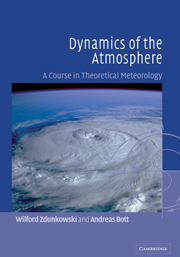Book contents
- Frontmatter
- Contents
- Preface
- Part 1 Mathematical tools
- Part 2 Dynamics of the atmosphere
- 1 The laws of atmospheric motion
- 2 Scale analysis
- 3 The material and the local description of flow
- 4 Atmospheric flow fields
- 5 The Navier–Stokes stress tensor
- 6 The Helmholtz theorem
- 7 Kinematics of two-dimensional flow
- 8 Natural coordinates
- 9 Boundary surfaces and boundary conditions
- 10 Circulation and vorticity theorems
- 11 Turbulent systems
- 12 An excursion into spectral turbulence theory
- 13 The atmospheric boundary layer
- 14 Wave motion in the atmosphere
- 15 The barotropic model
- 16 Rossby waves
- 17 Inertial and dynamic stability
- 18 The equation of motion in general coordinate systems
- 19 The geographical coordinate system
- 20 The stereographic coordinate system
- 21 Orography-following coordinate systems
- 22 The stereographic system with a generalized vertical coordinate
- 23 A quasi-geostrophic baroclinic model
- 24 A two-level prognostic model, baroclinic instability
- 25 An excursion concerning numerical procedures
- 26 Modeling of atmospheric flow by spectral techniques
- 27 Predictability
- Answers to Problems
- List of frequently used symbols
- References and bibliography
- Index
26 - Modeling of atmospheric flow by spectral techniques
Published online by Cambridge University Press: 05 June 2012
- Frontmatter
- Contents
- Preface
- Part 1 Mathematical tools
- Part 2 Dynamics of the atmosphere
- 1 The laws of atmospheric motion
- 2 Scale analysis
- 3 The material and the local description of flow
- 4 Atmospheric flow fields
- 5 The Navier–Stokes stress tensor
- 6 The Helmholtz theorem
- 7 Kinematics of two-dimensional flow
- 8 Natural coordinates
- 9 Boundary surfaces and boundary conditions
- 10 Circulation and vorticity theorems
- 11 Turbulent systems
- 12 An excursion into spectral turbulence theory
- 13 The atmospheric boundary layer
- 14 Wave motion in the atmosphere
- 15 The barotropic model
- 16 Rossby waves
- 17 Inertial and dynamic stability
- 18 The equation of motion in general coordinate systems
- 19 The geographical coordinate system
- 20 The stereographic coordinate system
- 21 Orography-following coordinate systems
- 22 The stereographic system with a generalized vertical coordinate
- 23 A quasi-geostrophic baroclinic model
- 24 A two-level prognostic model, baroclinic instability
- 25 An excursion concerning numerical procedures
- 26 Modeling of atmospheric flow by spectral techniques
- 27 Predictability
- Answers to Problems
- List of frequently used symbols
- References and bibliography
- Index
Summary
Introduction
The representation of atmospheric flow fields by means of spherical functions has a long history. Haurwitz (1940) represented the movement of Rossby waves by means of spherical functions. The development of the spectral method for the numerical integration of the equations of atmospheric motion goes back to Silberman (1954), who integrated the barotropic vorticity equation in spherical geometry. The spectral method attracted the attention of others and studies were performed, for example, by Lorenz (1960), Platzman (1960), Kubota et al. (1961), Baer and Platzman (1961), and Elsaesser (1966). Lorenz demonstrated that, for nondivergent barotropic flow, the truncated spectral equations have some important properties. Just like the exact differential equations, they preserve the mean squared vorticity, called enstrophy, and the mean kinetic energy. Platzman pointed out that this very desirable property automatically eliminated nonlinear instability, which at that time was a substantial difficulty in grid-point models. The early work made use of the so-called interaction coefficients to handle nonlinearity. This cumbersome procedure was replaced by the efficient transform technique for solving the spectral equations, which was devised independently by Orszag (1970) and by Eliasen et al. (1970). In compressed form the essential information on spectral modeling is given by Haltiner and Williams (1980). Much valuable information about spectral techniques – which is usually not readily available – can be extracted from the “gray” literature. We refer to an excellent report by Eliasen et al. (1970). Finally, we refer the reader to an excellent article on “Global modelling of atmospheric flow by spectral methods”, by Bourke et al. (1977).
- Type
- Chapter
- Information
- Dynamics of the AtmosphereA Course in Theoretical Meteorology, pp. 649 - 668Publisher: Cambridge University PressPrint publication year: 2003



